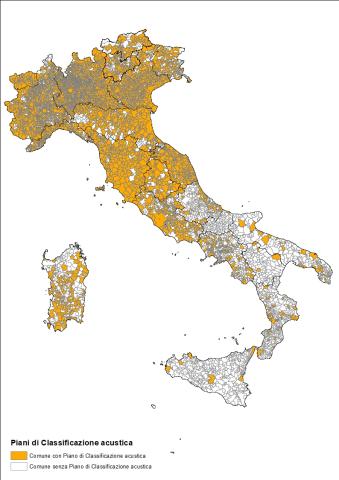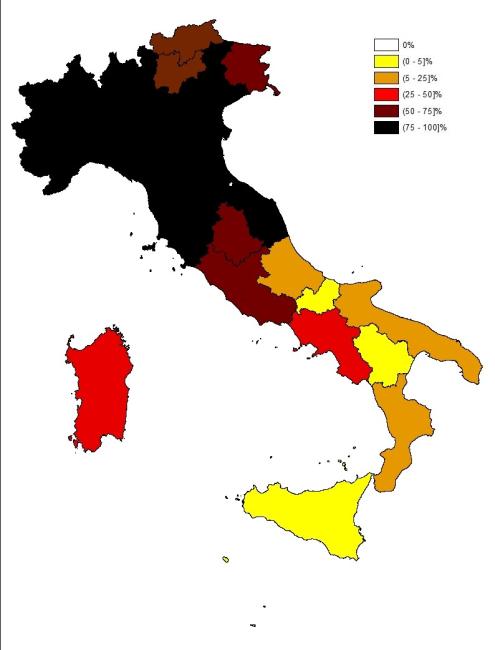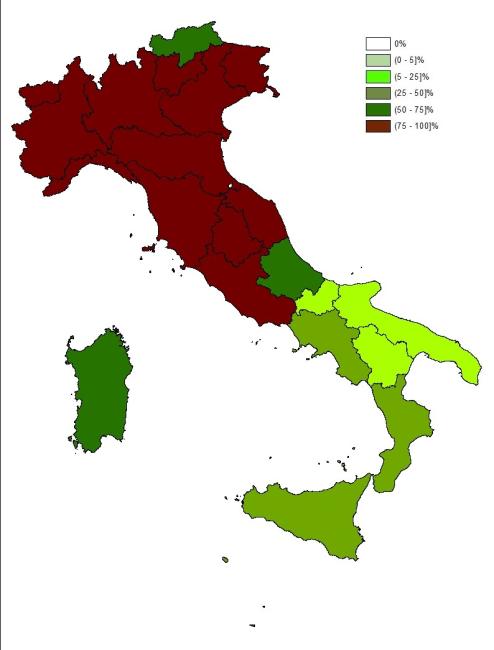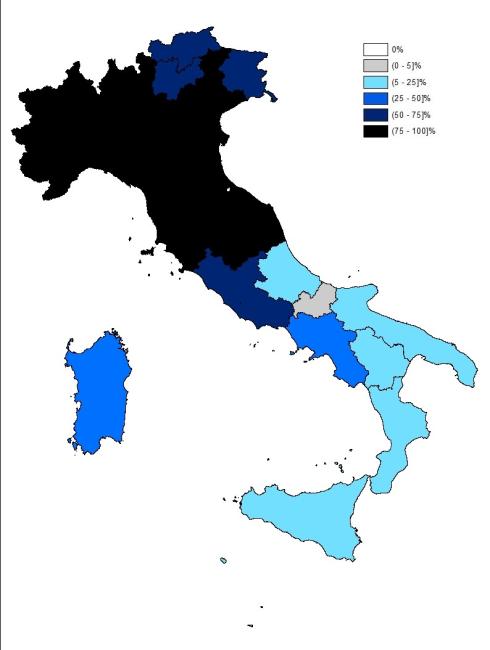Panel 1
Gabriele Bellabarba, Francesca Sacchetti
The Noise Zoning Plan is the primary municipal planning tool for managing noise pollution. This plan involves dividing the municipal territory into acoustically homogeneous areas, each assigned specific noise limits. Its goal is to provide an essential tool for urban development planning and territorial protection from noise pollution.
As of 2023, the Noise Zoning Plan has been approved in 64% of municipalities nationwide. However, significant regional disparities persist in the application of this planning instrument.
For each region/autonomous province, the indicator reports , the number of municipalities that have approved a Noise Zoning Plan and the percentage of those municipalities compared to the total. Additionally, it records, at both national and regional levels, the percentage of classified territory and the percentage of the population residing in municipalities with an approved Noise Zoning Plan, relative to total resident population.
To assess the implementation status of noise regulations concerning municipal administrations' activities in the prevention and protection of environmental noise pollution.
LQ 447/1995; DPCM 14/11/1997;
DPCM 01/03/1991
LQ 447/95 mandates that municipalities acoustically classify their territories (Art. 6, para. 1, letter a)), dividing them into six homogeneous zones based on their predominant land use. Each zone is assigned acoustic limit values for two-time frames: daytime and nighttime (DPCM 14/11/97, "Determination of Limit Values for Noise Sources"). LQ 447/95 assigns to regions the responsibility of defining the criteria for municipal noise classification (Art. 4, para. 1, letter a)). In the absence of a municipal noise classification plan, the temporary acceptance limits defined in Art. 6 of DPCM 1 March 1991 apply (Art. 15 of LQ 447/95).
Panel 2
APAT, AAVV 2008, Linee guida relative ai criteri per la classificazione acustica dei territori comunali
--
--
Data quality assessment
ARPA/APPA (Regional and Autonomous Provincial Environmental Protection Agencies), ISTAT (National Institute of Statistics)
The data for the calculation of the indicator are available in the Noise Observatory database, which can be updated by the ARPA/APPA representatives and is accessible, including to the public, via the website https://agentifisici.isprambiente.it/osservatoriorumore_public/home.php.
Nazionale, Regionale (20/20)
Update as of 31/12/2023.
Indicator assessment
The indicator measures the number of municipalities that have approved a Noise Zoning Plan and the ratio of those municipalities relative to the total number of municipalities.
In 2023, there was an increase of 80 municipalities with approved Noise Zoning Plan compared to 2022, mainly due to updated information from the Calabria region.
Overall, 64% of municipalities nationwide have approved a Noise Zoning Plan (Table 1).
Between 2006 and 2023, the percentage of municipalities with a zoning plan increased by 33 percentage points, from 2,552 municipalities in 2006 (31.5%) to 5,097 in 2023 (64.5%) (Table 2).
Data
Table 1: Municipalities, classified by Region/Autonomous Province, that have approved the Noise Mitigation Plan
ISPRA elaboration based on ARPA/APPA and ISTAT data
Table 2: Municipalities that have approved the noise classification
ISPRA elaboration based on ARPA/APPA and ISTAT data





As of 2023, the number of municipalities that have approved a Noise Zoning Plan is 5,097, representing 64.5% of all Italian municipalities. This figure is only slightly higher than in previous years (Table 2). Slight increases are also observed in:
• The percentage of the population residing in municipalities with an approved Noise Zoning Plan (73% of the total population)
• The percentage of zoned land area (58% of the national surface) (Table 1).
Significant regional disparities remain (Figures 2-4). The regions with the highest percentages of zoned municipalities are: Valle d'Aosta (100%), Lombardy, Tuscany, and Marche (96%), Veneto (94%), Liguria (85%), Piedmont (82%), Emilia-Romagna (78%); meanwhile, regions with less than 20% zoned municipalities include: Abruzzo (17%), Puglia and Calabria (13%), Basilicata (3%), Sicily (2%) and Molise (1%).